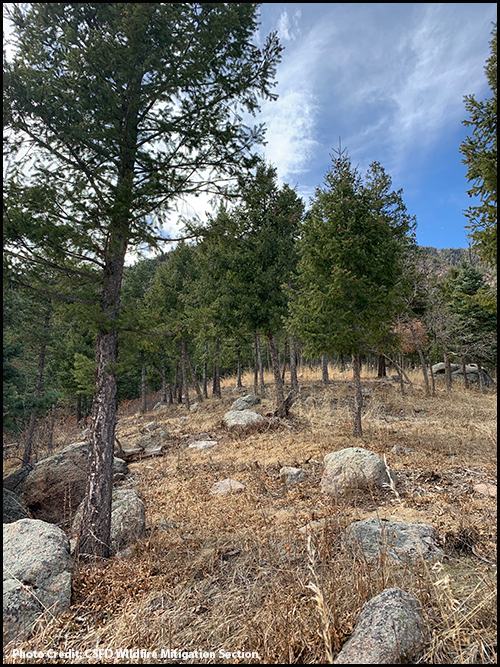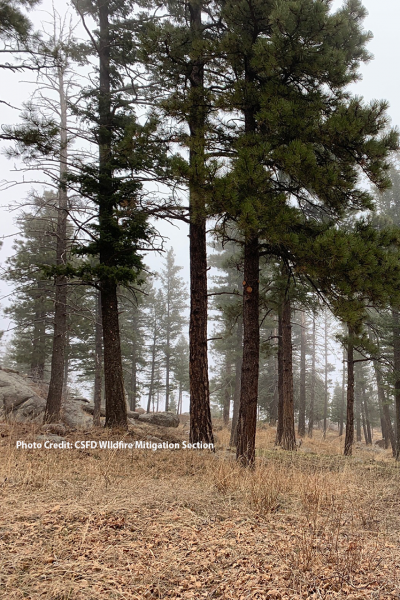Part of what makes Cheyenne Mountain Zoo so special is its beautiful forested mountainside landscape. In addition to maintaining and improving animal exhibits, guest areas and behind-the-scenes animal care spaces, CMZoo works to responsibly manage its expansive grounds, of which many guests might not be aware.

“The Zoo property spans 142 acres on the mountainside and 70 of those acres are developed, so there’s a lot going on behind the scenes to keep our Zoo and surrounding community safe – especially at a time when wildfires are increasingly common in our area,” said Dave Ruhl, vice president of operations and campus planning at CMZoo. “Like many Colorado forests, our landscape experiences damaged and downed trees from insects and the natural cycle of regeneration. It’s important for Colorado Springs residents to participate in fire mitigation practices, and we’re hoping to inspire others to feel that shared accountability to help protect our local wildlife, open spaces and nearby structures.”
This project is made possible thanks to a generous gift from The Dusty Loo Family and a matching grant. The Zoo first started working with the Colorado Springs Fire Department (CSFD) on a fire mitigation plan in 2011. The plan encompasses approximately 72 acres of natural undeveloped land surrounding the Zoo. To date, the team has mitigated nearly 25 acres of that undeveloped property. There are 47 acres of undeveloped land that need to be addressed, as well as a section of the Zoo that was mitigated in 2011 that needs to be revisited.
In early March, the Zoo, in partnership with Colorado Springs Fire Department, Wildfire Mitigation Section, continued work on its long-term fire mitigation plan, focusing on nearly 22 undeveloped acres of forest above Asian Highlands and Rocky Mountain Wild. This priority project is expected to take about 8 weeks to complete. If guests hear heavy equipment near the top of the Zoo, it’s probably due to this important work. The fire mitigation team is working with CMZoo’s animal care team to make sure the noise doesn’t negatively impact the Zoo’s animal residents who live nearby.
“We’re clearing large fallen trees, branches and brush in that area,” said Ruhl. “We’re grateful to have CSFD and Front Range Arborists on our team. We bring the specific local knowledge of our landscape, the contractor manages the complicated removal logistics plans and provides the manpower, and CSFD brings the fire mitigation expertise.”
The most recent fire season resulted in Colorado experiencing its worst fire year ever, in 2020. In Colorado Springs, on November 11, 2020, the Bear Creek fire burned more than 25 acres just a few miles north of the Zoo. Because of the proactive fire mitigation efforts of residents in that area and a quick response from firefighters, dozens of homes were saved.
“Spring is a great time to see if your property needs any attention before the next inevitable wildfire season,” said Ruhl. “When we keep our own backyards free of extra debris, we help our entire community and our firefighters respond to more manageable wildfires.”
With that in mind, CMZoo encourages all community members to help each other and our local flora and fauna, by taking the following fire mitigation advice provided by the Colorado Springs Fire Department, Wildfire Mitigation Section.
- Create a 30-foot defensible space surrounding homes, including rooflines and decks. This includes thinning out vegetation, trimming up trees and planting fire-resistant species close to structures.
“What we hope to see on every homeowner’s property is 15 feet of clearance from tree branches to the structure,” said CSFD Wildfire Mitigation Program Coordinator, Melissa Hoffman. “We know this isn’t always possible, but the goal is to create as much clearance as you can, while still maintaining the health of the trees.” - Trim lower branches of trees up to 10 feet, as long as that leaves at least 70% of the tree’s canopy. Pruning trees and removing ‘fuel ladders,’ like lower branches, will help keep a fire on the ground verses it climbing up into the canopies of the trees.
- When possible, use ‘home hardening’ features, like stucco siding, instead of wood. Composite decking material is another option that’s more ignition resistant than wood decking.
- Rake and remove leaves and needles at least 15 feet around your home.
- Keep your roof, gutters, and window wells cleared of leaves and needles.
- Consider placing landscaping rock 1-3 feet directly around the perimeter of any structures. Wood mulch should be at least 3 feet away from a structure and no more than 4 inches in depth.
- Pick your trees wisely. Hazardous brush or trees, such as junipers and conifers, should not be planted within 15 feet of a structure due to their high oil and resin content. Hoffman says those species burn hot and fast, so avoid having them near structures that the fire could jump to.
“Our tagline here at CSFD Wildfire Mitigation Section is ‘Sharing the Responsibility’,” said Hoffman. “If homeowners can do their part on the front end, it makes it much more manageable for our firefighters to do their jobs in protecting homes during a wildfire event.”
CSFD’s Wildfire Mitigation Section offers free onsite consultations for residents. Team members will come to Colorado Springs residences and provide recommendations for mitigating fire risks around the home. Schedule a free onsite consultation by calling (719) 385-7493. Colorado Springs residents can find more information and requirements at coloradosprings.gov/wildfiremitigation.

